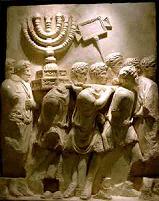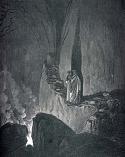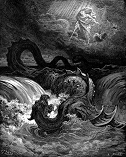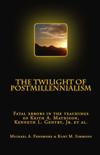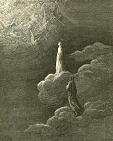Demons and Unclean Spirits shown to be
Madness, Epilepsy, and other Physical Maladies
Commentary on Matthew Chapter Four
[Editor’s note: Here follows an excerpt from our commentary
on Matthew Four, in which we discuss the question of
demoniacs and unclean spirits. The reader is encouraged to
follow up by reading the
article by
S. Snobelen, showing that attribution of physical
and mental maladies to demons was a regional phenomenon,
confined to Galilee of the Gentiles, and therefore a
question of regional superstition and terminology. However,
these articles should not be interpreted as an endorsement
of modernistic trends to rationalism or deny of the Bible’s
inspiration and inerrancy, of which we are firmly committed
and convinced. Realizing not all will agree with these
pieces, as always, let each man be persuaded in his own
mind. ]
And they brought unto him all sick people
that were taken with diverse diseases and torments,
Since
Matthew already reported that Jesus healed all manner of disease
among the people of the Jews dwelling in Galilee, we must
conclude that those mentioned here are Jews from other parts of
Palestine together with Gentiles dwelling in Syria.
and those that were possessed with
devils,
There
are two basic views about devils, demons, and unclean spirits.
One view has it that they are supernatural beings, either the
spirits of the wicked dead, or fallen angels; that Satan’s
proper name is Lucifer; that he was chief among the angels, but
sought to be equal with God and thus led a revolt in heaven, but
was defeated by Michael and his angels and was cat down to
earth, where his inveterate hatred for God drives him to wreak
havoc, tempt man, and persecute God’s people. Further, Adam’s
sin gave Satan dominion in earth and over death and Hades, where
he reigns, tormenting the souls of the damned.
Another
view is that the angels do not have free will, but being spirit
cannot be tempted with evil, and therefore cannot fall or
revolt. The terms devil and Satan are used various ways in
scripture. Sometimes they refer to a source of evil or
temptation (Matt. 16:23, Simon Peter; Jn. 6:70,
Judas Iscariot), women guilty of
malicious gossip (I
Tim. 3:11; Tit. 2:3 – where diabolos is translated false
accuser/slanderer), other times
to an enemy nation or persecuting power
(Zech. 3:1; Rom. 16:20), and other times as a personification of
an inanimate object such as an idol (I Cor. 10:20; cf.
Ex. 34:15; Lev. 17:7; Deut. 32:17; II Chrn. 11:15), or something
abstract, like sin (Heb. 2:14; cf. Gen. 4:7). The
Hebrew word “satan” is not a proper name, but a generic term
that signifies an
adversary or opponent. It first occurs in Numbers 22:22
where it is used of the angel of the Lord when he stood as an
“adversary” to Balaam. The same term is used of the Philistines
vis-à-vis David (I Sam. 29:4); and the adversaries of
Solomon are likewise so called several times (I Kng. 5:4; 11:14
– Hadad the Edomite; I Kng. 5:4:23, 25 - Rezon, the
son of Eliadah). When I Chron. 21:1 says that “Satan stood
up against Israel, and provoked David to number Israel,” the
adversary almost certainly was not a demonic being, but an enemy
nation, probably the Philistines (cf. II Sam. 24:1).
In
Zechariah, the prophet records a vision thought to confirm the
existence of a supernatural agent called Satan: The prophet saw
Joshua the high priest in filthy garments and Satan standing at
his right hand to accuse him. However, the passage is symbolic.
Joshua represents the children of Israel returned out of
captivity; the marginal reading calls Satan “an adversary.” When
we consult the historical situation behind the vision, we find
that the Jews were attempting to rebuild the temple, but were
hindered and opposed by the governing authorities of the region,
who persuaded the king of Persia to stop the work (cf.
Dan. 10:13; Ezra 4; Neh. 4). However, it was the ministry of the
prophets Zechariah and Haggai to encouraged the people to
continue the work of rebuilding the temple (Ezra 5:1; Zech.
4:9). Hence, it is almost certain this is the meaning of the
vision, and that the Persian monarchy and governing authorities
opposing the work are the adversary represented by “Satan.”
In
Revelation, John depicts a battle in heaven in which a dragon
and his angels fight with Michael and his angels (Rev.12:7-11).
The dragon is often interpreted as Satan. But here again the
passage is symbolic and should not be interpreted literally. The
better view is that battle represents the earthly ministry of
Christ and that of his disciples. Michael is Christ; his angels
are the disciples and messengers of the gospel. The dragon
hearkens back to the serpent in the garden and is a
personification of sin and death; his angels are those who
oppose the gospel. Following our first ancestors’ fall, God said
that he would put enmity between the seed of the woman and the
seed of the serpent; the serpent’s seed would bruise his heel,
but it would crush the serpent’s head. (Gen. 3:15). The seed of
the woman was Christ; the seed of the serpent were the children
of disobedience (the Romans and Jews) (Jn. 8:44). The serpent
would strike the promised Seed in the crucifixion through the
Jews and Romans acting in obedience to the impulse of sin and
disbelief, bruising his heel; but Christ would crush its head.
The sting (venom) of death (the serpent) is sin; the strength of
sin was the law (I Cor. 15:56). By his substitutionary death and
atoning blood the law was fulfilled and taken out of the way,
“spoiling principalities and powers” (Col. 2:13-17). In his
resurrection, Jesus delivered the crushing blow to the serpent
(II Tim. 1:10). Death, which had ruled from Adam to Moses as the
prince of this world (Rom. 5:14, 17; Jn. 12:31; 14:30; 16:11),
was cast out, and its principality destroyed.[1] Thus, John
says Michael and his
angels overcame the dragon and his angels “by the blood of the
Lamb, and by the word of their testimony; and they loved not
their lives unto the death” (Rev. 12:11). This shows that the
battle concluded with the cross and preaching of the gospel, and
was not a literal battle waged in heaven at all.
Regarding
the term “Lucifer,” this word is derived from the Latin Bible
and is a compound made up of “lux” (light) and “fere” (to bear).
It occurs in Isa. 14:12 in reference to the king of Babylon
(Isa. 14:4), where it translates the Hebrew “heylel,”
“Venus” or “the morning star.” The same term also occurs in the
Latin Bible at II Pet. 1:19:
“We have also a more sure
word of prophecy; whereunto ye do well that ye take heed, as
unto a light that shineth in a dark place, until the day dawn,
and the day star (“lucifer”) arise in your hearts.”[2] Here we see that the term
is not a proper name at all and has no reference whatever to a
demonic being or fallen angel.
Unclean
spirits and demonic possession seem to be no more than physical
and mental illness, the Jews having learned to refer to them
this way beginning with the Babylonian captivity and the Greek
conquest of Palestine. No cases of demonic possession occur in
the Old Testament, and those recorded in the gospels occur
exclusively in Galilee, the Decapolis, and other areas heavily
populated by Gentiles. When Jesus heals men afflicted by
physical maladies in those regions, it is often described as
casting out an unclean spirit, but the same afflictions and
miracles of healing in Judea make no reference to devils
whatever. Hence, the whole thing seems to be nothing more than
the regional superstition and terminology of those living in
areas populated by Gentiles, similar to today where in the West
there are no occurrences of demonic possession, but in Africa
and other superstitious and uneducated areas of the globe,
belief in evil spirits is wide spread and bodily ailments are
commonly attributed to this source. This is confirmed by Bishop
Lightfoot, who gives the following account of demonic
possession:
“There
were divers diseases, which, in their own nature, were but
natural diseases, which yet the Jews did, commonly, repute as
seizure and possessing by the devil; especially those that
distempered the mind, or did in more special manner convulse the
body: and, according to this common language and conception of
the nation, the language of the gospel doth speak exceeding
frequently. Examples of this kind of dialect among the Jews, we
might produce divers, as that in Maimonides:
‘A man, which is troubled with an evil spirit, and saith,
when the sickness
 begins
upon him, Write a bill of divorcement to my wife, he said as
good as nothing, because he is not
‘compos sui’: and so likewise a drunken man, when he comes near the
drunkenness of Lot,’ etc.
he calls the evil spirit
begins
upon him, Write a bill of divorcement to my wife, he said as
good as nothing, because he is not
‘compos sui’: and so likewise a drunken man, when he comes near the
drunkenness of Lot,’ etc.
he calls the evil spirit
 ,
or ‘a sickness;’ and by it he means lunacy, or distractedness,
that had its ‘lucida intervalla.’ So the Jews speak of a man ‘that is possessed
by Cordicus:’ which they interpret to be, ‘a spirit that seizeth
on him, that drinketh too much wine out of the wine-press.’
And, to spare more; because the story in hand is of a
child, take but this example of an evil spirit, which, when
conceived, did seize upon children: ‘Shibta (say they) is an
evil spirit, that seizeth upon children by the neck, even upon
the sinews behind the neck, and drieth them up from their use
and strength, till it kill him.
And the time of it is from the child’s being two months
old, and the danger of it is till the child be seven years old.’
Which seemeth to mean nothing else but convulsion-fits, or
shrinking of the sinews, or some suchlike thing; a natural
malady.”[3]
,
or ‘a sickness;’ and by it he means lunacy, or distractedness,
that had its ‘lucida intervalla.’ So the Jews speak of a man ‘that is possessed
by Cordicus:’ which they interpret to be, ‘a spirit that seizeth
on him, that drinketh too much wine out of the wine-press.’
And, to spare more; because the story in hand is of a
child, take but this example of an evil spirit, which, when
conceived, did seize upon children: ‘Shibta (say they) is an
evil spirit, that seizeth upon children by the neck, even upon
the sinews behind the neck, and drieth them up from their use
and strength, till it kill him.
And the time of it is from the child’s being two months
old, and the danger of it is till the child be seven years old.’
Which seemeth to mean nothing else but convulsion-fits, or
shrinking of the sinews, or some suchlike thing; a natural
malady.”[3]
and those which were lunatic, and those
that had palsy; and he healed them.
The
word “lunatic” means “moonstruck,” and describes someone who is
insane or suffers convulsions or epilepsy. However, lacking knowledge of medical science, the Jews and
other superstitious peoples fell into the error of supposing men
were possessed with devils, an error common to this day among
the primitive peoples of Africa and other countries.
Thus, in Matt. 17:14-21, a father brought his child to Jesus
saying he was “lunatic” (v.15), but in healing the child Matthew
describes Jesus as having “rebuked the devil” (v.18). In the
parallel account in Mark, the father said his son had a “dumb
spirit, and wheresoever he taketh him, he teareth him: and he
foameth, and gnasheth with his teeth, and pineth away” (Mk.
9:17, 18). But who cannot see that the child suffered epilepsy
or some form of recurring seizure, and was not possessed by a
devil? Indeed, Thayer defines “lunatic” (selhniazomai)
as epilepsy: “to be moon-struck (cf. lunatic); to be epileptic
(epilepsy being supposed
to return and increase with the increase of the moon): Mt.
iv.24; xvii:15.”[4]
[1]
“He destroyed the enemy and the avenger, and
death the prince of this world, together with the other
unseen hostile powers.”
Eusebius, Demonstratio Evangelica, VIII,
ccclxxvii; Ferrar ed.
[2]
“et habemus firmiorem propheticum sermonem cui bene facitis adtendentes
quasi lucernae lucent in caliginoso loco donec dies
inlucescat et lucifer oriature in cordibus vestris”
[3]
John Lightfoot,
Harmony of the
Gospels, Complete Works (1684) Vol. 3, pp. 102, 103
[4]
J. H. Thayer,
Greek-English Lexicon (Fourth Edition), p. 573
To receive Kurt Simmons’ e-mail newsletter, The Sword & The Plow, click the Subscribe
link:
SUBSCRIBE
All rights reserved.
![]() begins
upon him, Write a bill of divorcement to my wife, he said as
good as nothing, because he is not
‘compos sui’: and so likewise a drunken man, when he comes near the
drunkenness of Lot,’ etc.
he calls the evil spirit
begins
upon him, Write a bill of divorcement to my wife, he said as
good as nothing, because he is not
‘compos sui’: and so likewise a drunken man, when he comes near the
drunkenness of Lot,’ etc.
he calls the evil spirit
![]() ,
or ‘a sickness;’ and by it he means lunacy, or distractedness,
that had its ‘lucida intervalla.’ So the Jews speak of a man ‘that is possessed
by Cordicus:’ which they interpret to be, ‘a spirit that seizeth
on him, that drinketh too much wine out of the wine-press.’
And, to spare more; because the story in hand is of a
child, take but this example of an evil spirit, which, when
conceived, did seize upon children: ‘Shibta (say they) is an
evil spirit, that seizeth upon children by the neck, even upon
the sinews behind the neck, and drieth them up from their use
and strength, till it kill him.
And the time of it is from the child’s being two months
old, and the danger of it is till the child be seven years old.’
Which seemeth to mean nothing else but convulsion-fits, or
shrinking of the sinews, or some suchlike thing; a natural
malady.”[3]
,
or ‘a sickness;’ and by it he means lunacy, or distractedness,
that had its ‘lucida intervalla.’ So the Jews speak of a man ‘that is possessed
by Cordicus:’ which they interpret to be, ‘a spirit that seizeth
on him, that drinketh too much wine out of the wine-press.’
And, to spare more; because the story in hand is of a
child, take but this example of an evil spirit, which, when
conceived, did seize upon children: ‘Shibta (say they) is an
evil spirit, that seizeth upon children by the neck, even upon
the sinews behind the neck, and drieth them up from their use
and strength, till it kill him.
And the time of it is from the child’s being two months
old, and the danger of it is till the child be seven years old.’
Which seemeth to mean nothing else but convulsion-fits, or
shrinking of the sinews, or some suchlike thing; a natural
malady.”[3]